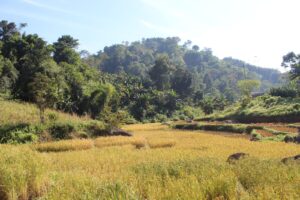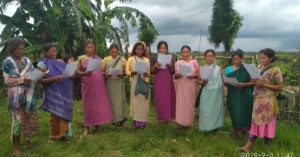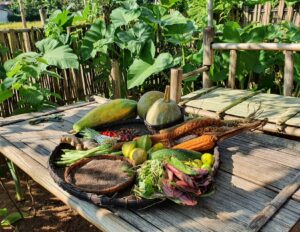Written by Shreya Vetal, Azim Premji University
In evergreen East Khasi Hills, the village of Ladmawphlang stands as a beacon of community-driven conservation. With over 105 families and a population of 528, this village has embraced preservation of its rich biodiversity through the dedicated efforts of its Biodiversity Management Committee (BMC). Supported by the Meghalaya Biodiversity Board, NESFAS, and with assistance from The Nature Conservancy, the village is on a transformative journey with “Preparation of People’s Biodiversity Register (PBR)” project which was initiated in March 2023.
The creation of PBR marked a significant milestone, providing a comprehensive baseline for the community to assess and protect their local biodiversity. With detailed documentation of flora, fauna, indigenous customs, and traditional knowledge, the BMC and community members could visualize their natural heritage and its needs more clearly. This newfound clarity triggered the design of a prospective landscape management plan aimed at sustainable resource use and biodiversity conservation.
Ladmawphlang’s land cover tells a story of a village deeply intertwined with nature: 74.33 hectares of village forest, 10.816 hectares of restricted forest, 19.64 hectares of agricultural land, 16.90 hectares of scrubland, 2.68 hectares of river, 0.12 hectares of water bodies, 0.05 hectares of waterfalls, 12.27 hectares of settlement area, and 3.46 hectares of barren land. These figures reflect a community that understands the importance of each type of land in maintaining ecological balance. Water bodies like Wah Umiong, Wah Heh, Wah Raniaw, and Wah Khlaw are vital lifelines, providing water for drinking, washing, and other household needs.
The community has a longstanding tradition of conservation, understanding the importance of safeguarding these invaluable resources. Demonstrating their dedication to sustainable living, they have established six community reserved forests: Law Wei Thanglar, Shiliang Wahumiong, Riat Liewlong, Niangblah, Riat Kong Di, and Khlaw Kyndongriat. Each of these reserved forests play a crucial role in maintaining the ecological balance and supporting the diverse biodiversity of the region. By protecting these areas, the community ensures that the habitats of various plant and animal species are preserved, promoting ecological stability and resilience. Unlike many communities that harvest resources from their forests, this community has taken a different approach by reserving two more plots, from Themkharai to Wahsaitsnier (Newly Declared Community reserve forest) and from Pungbiro to Lad Wahumiong (New declared reserved forest) specifically for the purpose of expanding their forests.
Ladmawphlang has opted to safeguard these forests to ensure a continuous and sustainable growth of their forests. This proactive strategy not only prevents deforestation but also promotes reforestation, enhancing the capacity of these ecosystems to provide essential services such as water filtration, carbon sequestration, and soil stabilization.
Ladmawphlang’s conservation ethos is supported by strict community regulations. The village Durbar’s rules prevent careless exploitation of natural resources and promote sustainable practices. Children, for example, must be accompanied by adults when collecting firewood, ensuring they learn proper collection methods. Initiatives like “Friends of the Earth” encourage the planting of fast-growing and fruit-bearing trees to sustainably meet firewood and fruit needs. Annual forest clean-ups and the creation of fire lines to prevent wildfires are community rituals that embody their proactive stance. The careful harvesting of older trees every five or six years ensures forest density and allows new growth. Sand collection is limited to domestic use, preventing commercial exploitation, and water bodies are cleaned multiple times a year to maintain their purity. The village council’s strict protection rules include prohibitions on hunting, using poisons for fishing, collecting stones near river banks, burning grasslands, and drilling underground water. The community holds pine trees and bay berries (Sohphie) in high regard; they should not be chopped down as they are precious for the community. Violators of these rules face severe fines, considering the seriousness of these protections.
The PBR project not only highlighted existing practices but also inspired new initiatives. The BMC, with the support of the village Durbar, has since declared additional forest areas as community reserves. Community nurseries, initiated by eight households, aim to raise 1000 saplings each, contributing to the restoration of degraded lands. With a survival rate of 99%, the planting of 7000 trees marks a significant achievement in ecological restoration. Ladmawphlang plans to transform agricultural land to organic farming, protect aquatic life by declaring parts of Wahumiong River a fish sanctuary, and creating a biodiversity park. They intend to start a Mother Earth Café aimed to provide livelihood opportunities while promoting conservation.
The conservation legacy of Ladmawphlang village gives us the example of the power of community-driven initiatives and local governance. By combining traditional knowledge with modern conservation strategies, the community members are not only preserving their natural heritage but also ensuring a sustainable future. Their efforts underscore the importance of living in harmony with nature, offering a blueprint for other communities to follow in the global fight against biodiversity loss and climate change.





